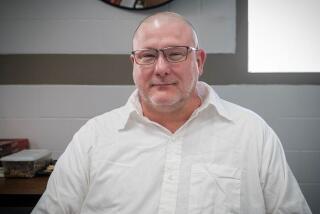As Arizona inmate gasped in execution chamber, legal drama unfolded
From the day Joseph Rudolph Wood III was condemned to death, it had taken 23 years for Arizona to finally get him into the execution chamber.
And at 1:52 p.m. Wednesday, when the executioners began to fill Wood’s veins with poison, none of the witnesses gathered at the state prison in Florence — none of the reporters, lawyers, public officials or family members of Wood’s two victims — knew it would take nearly two more hours to kill him.
Witnesses would later say Wood, 55, repeatedly struggled for breath. One would call it “death by apnea.”
In the execution chamber at Housing Unit 9, and at a Phoenix federal courthouse 65 miles away, an extraordinary drama unfolded as Wood’s attorneys tried to halt an execution that, they told a judge, had clearly gone awry.
A transcript of the attorneys pleading with the judge to move swiftly and accounts from witnesses paint an unusually detailed, and disturbing, narrative of what happened over the last 117 minutes of Wood’s life.
Wood had already escaped death once. Had the Tucson police officers’ bullets flown just a little bit truer, the government might have killed him in 1989.
One morning in August of that year, Wood, who was under a restraining order for threatening behavior, walked into the Tucson auto shop where his estranged girlfriend and her father worked and shot Eugene Dietz, 55, once in the chest.
Employees at the shop would later say that he smiled after he pulled the trigger. Then, as Debra Dietz, 29, tried to call for help and begged him to stop, Wood grabbed her and said, “I have to kill you.” Which he did, shooting her twice.
When Wood walked out of the auto shop, two officers were waiting, and they shot him several times.
Science, in the form of surgery, had saved his life, and this week it was supposed to help end it. Executioners were under orders to inject Wood with two drugs: midazolam, an anesthetic, combined with hydromorphone, an opioid.
Some lethal injection executions succeed within 10 minutes. But at 2:02 p.m., 10 minutes after drugs began flowing, observers noticed movement.
“At 2:05, Wood’s mouth opened,” wrote Michael Kiefer, an Arizona Republic reporter who witnessed the execution. “Three minutes later it opened again, and his chest moved as if he had burped. Then two minutes again, and again, the mouth [opened] wider and wider. Then it didn’t stop.”
The noises Wood made have since become a matter of interpretation. His attorneys described it as gasping and snorting. A spokeswoman for the state attorney general’s office called it peaceful snoring.
Kiefer said Wood was “sucking, similar to when a swimming-pool filter starts taking in air, a louder noise than I can imitate.”
Gasping or snoring. Suffering or peaceful. One fact was beyond dispute: Wood was alive when he wasn’t supposed to be. “I don’t think he’s going to die,” Kiefer recalled whispering to a reporter next to him. The other reporter whispered back, “I think you’re right.”
Wood’s attorneys rushed to the phone.
“Do you have an assistant attorney general there?” federal Judge Neil V. Wake asked when they called.
“I do not,” said Robin C. Konrad, one of Wood’s attorneys. “I’m in the office right now.”
It was 3:28 p.m., more than an hour after the execution began, and medical personnel had checked to make sure Wood wasn’t conscious.
Konrad asked Wake to order prison staff to halt the execution and try to resuscitate Wood. But there was a problem: There was no prosecutor or state official on the phone to debate the defense’s highly unusual request.
“Do you have any — do you have numbers for any of these people?” the judge asked Konrad in remarks that were captured by a court reporter. “The reality is we’ll take anybody I can reach, but we should start with the most appropriate person.”
The judge didn’t know how to work the conference-calling feature on his phone. As Wood clung to life, it took a couple of minutes to reach Jeffrey A. Zick, chief counsel of the Arizona attorney general’s office.
“I am told that Mr. Wood is effectively brain-dead and that this is the type of reaction that one gets if they were taken off of life support,” Zick told the judge, saying that at some point, another dose of drugs had been administered. “The brainstem is working, but there’s no brain activity.”
For several minutes, as a macabre scene of half-death continued to play out at the Arizona State Prison Complex, Zick, Wake and Konrad debated the state’s claim that Wood was brain-dead, and then discussed the apparent confusion over the state’s contingency plan for a botched execution. Or whether it had one.
The judge said he was “very concerned” that trying to wake up Wood would do more harm than waiting for him to die.
In the observation area of the prison, an Associated Press reporter, Astrid Galván, had counted Wood’s gasps coming every five to 12 seconds, scrawling the times of his breaths on several sheets of ruler-lined paper. Kiefer, the Arizona Republic reporter, made pencil strokes for each breath. His count had gotten up into the hundreds.
At 3:47 p.m. the conference call with the judge continued, and the state attorney had an update: Wood’s breathing had stopped and his heart rate was falling.
“I’m not sure what more to say other than we’re requesting the stay of execution. I’m not sure if that’s possible at this time,” Konrad said.
The judge had to make a decision.
“Looking at this from the perspective of 8th Amendment prohibition of cruel and unusual punishment, I look at this in terms of what can be done, if anything, to eliminate or reduce pain that may be experienced,” the judge said.
But in the middle of delivering a decision, word arrived that Wood was pronounced dead at 3:49 p.m.
At the prison, Kiefer had made more than 640 pencil strokes.
The curtains closed over the window of the execution chamber and the witnesses filed out. Some called what happened torture, others called it justice.
At the courthouse, the judge said he had moved as quickly as possible and thanked both sides for their efforts. Then he had another thought.
“Mr. Zick, there are no other warrants of execution out for any of the other plaintiffs, correct?” he asked.
“Correct, judge.”
There would be time, the judge said, to deal with “whatever consequences” might arise after Wednesday’s execution.
He added, “We will be adjourned.”
More to Read
Start your day right
Sign up for Essential California for news, features and recommendations from the L.A. Times and beyond in your inbox six days a week.
You may occasionally receive promotional content from the Los Angeles Times.







